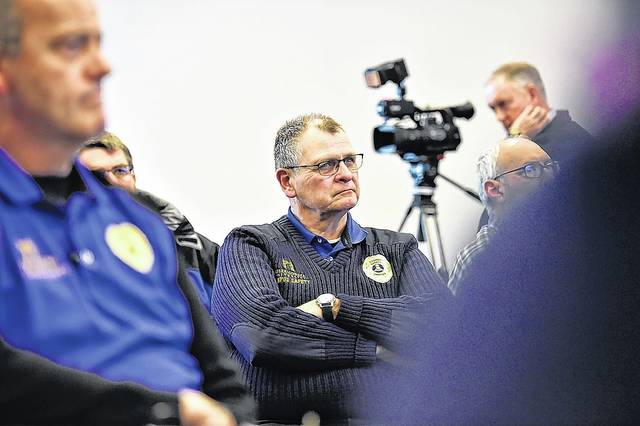DALLAS TWP. — The numbers sound truly “mind-blowing,” as Janine Olshefski put it more than once: 85 out of every 100 Luzerne County residents had an opioid prescription in 2016. The opioid overdose death rate in the county was 43.6 per 100,000 people, higher than the state rate of 36.5, and more than double the national rate of 16.3.
“And there is no clearly identifiable type of person,” the education specialist from Wyoming Valley Alcohol and Drug Service, Inc. told a crowd of 25 Misericordia University employees Wednesday.
“It’s every income, every race, every population,” Olshefski explained at the start of a two-hour seminar for campus safety and residence life officers. “We are in a crisis.”
Olshefski’s seminar was funded through grants from United Way of Wyoming Valley, the Luzerne Foundation and Geisinger Health, and included training in the administration of the anti-overdose drug known as Narcan. Spokesman Paul Krzywicki stressed “the training is a proactive approach by the university in case a need arises in the future to use Narcan.”
Olshefski gave a quick overview of the history of opioid use, from as far back as opium from poppy plants in 3400 B.C. in Southwest Asia through the use of morphine derived from the same source to the developmentof highly potent and highly addictive pain killers in the 1990s.
Those painkillers have been implicated in the dramatic rise of heroin use. “Nearly 80 percent of Americans using heroin report beginning with prescription medicines,” Olshefski said.
Initially, medicines like Oxycontin were “time-released,” meaning one pill would provide pain relief intermittently over several hours. But abusers figured out that crushing the pill eliminated the time factor and created a powerful high all at once.
The price of pills was far more expensive than heroin — as much as $40 a pill compared to $5 for a bag of heroin — even though both caused the same sensation so prescription drug abusers quickly turn to the more readily accessible heroin. A sort of arms race for new highs ensued.
“Codeine is two to three times more potent than morphine,” Olshefski said. “Fentanyl is 50 times stronger than heroin. … Carfentanil is 100 times more potent than Fentanyl and 10,000 times more potent than morphine.” In fact, the last one was developed to work on large animals such as elephants. Humans, she said, don’t get addicted to Carfentanil because it is lethal.
The problem is that dealers cut fentanyl and even Carfentanil into heroin, and users don’t know what they are getting, making overdoses more frequent and making the addiction harder to break.
Olshefski did not mince words when she brought up a lawsuit filed by Luzerne County against drug manufacturers and distributors, alleging they flooded the market with highly addictive prescription opioids while insisting the addiction risk was low.
“It is similar, to me, to tobacco,” when cigarette companies were sued by attorneys general from 46 states, alleging their product caused numerous public health problems. That suit resulted in the 1998 Tobacco Master Settlement Agreement with four tobacco companies in which five companies agreed to pay out $246 billion over 25 years.
Efforts to combat the epidemic include new manufacturing techniques that make prescription opioids ineffective if crushed, shorter prescription times (CVS Health has restricted prescriptions to seven days), and new drugs that block the opiate receptors in users so they don’t get a high. In fact, they can get sick.
Narcan has become widely available in the hope of saving lives. It quickly restores a person’s breathing and heart rate if an overdose threatens to slow them so much as to kill the user. But Olshefski conceded the user can’t be forced into rehab, and that there have been cases where a user was saved from an overdose only to try to get high again the same night, prompting another call for an ambulance and another dose of Narcan.
But it’s an uphill battle, in part because Americans seem to want instant pain relief when they visit a doctor.
“We are prescribing above and beyond any other country,” she said. “America represents 97.7 percent of the Hydrocodone world market.
“We make up only 5 percent of the world’s population, but we consume 75 percent of the the world’s prescription drugs.”





